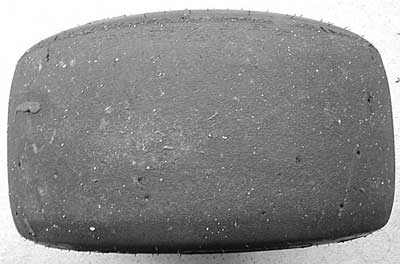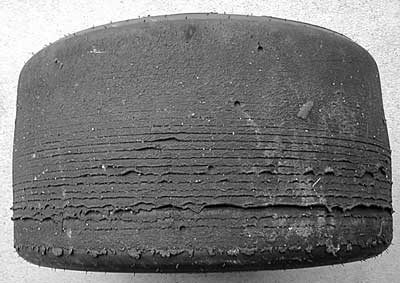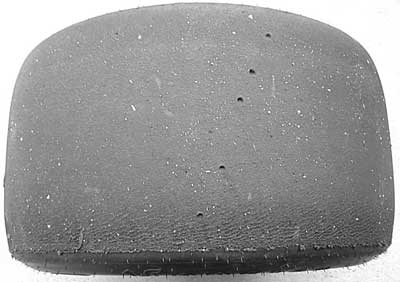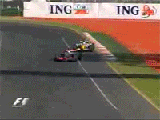Well,
some factual notes I made while googling around this theme:
Three cars did one stop strategy, so durability was strong.
Hamashima claimed they will analyze data to understand what happened. Last year he said the same thing, when Hamilton had the same problem: his tyre delaminated in turn 8.
Hamashima said to ITV that Bridgestone only request was that Hamilton stint had to be 18 laps maximum, stopping in laps 20 and 38. It was McLaren decission to do it in four stints or three stops.
Bridgestone claimed that "track and ambient temperature did not cause any issues".
Last year Sport Bild and some other papers blamed Alonso for not sharing his telemetry and for "demanding secrecy from McLaren" (!).
Kovalainen, in a heavier car, outqualified Hamilton, he did seven (!) more laps in his first stint.
Delamination is a fancy word for chunks of rubber ripped out of the tyre: the thread parts company with the carcasse.
It's the opossite of "chatter", where the tyres simply develop more force than the chassis can handle.
The ones I've seen happened because you heat a tyre too much. For example, bycicle tyres delaminate when used in rolling wheel trainers, indoors, because the rollers heat the tyres.
Delaminated tyre after a crash, maybe manufacturers fault, maybe extreme forces during the accident

In race cars, delamination is normally caused because you have a setup with lots of understeer. You have understeer, you turn too much the front tyres, the tyres get heated, they develop patches of soft rubber that get hardened in the following braking, in the entrance to the next curve, and there go marbles or strips out of your tyres.
Delaminated strip in the road typical of long distance roads, where the truck tyres get heated under heavy load and in long runs

You make your pit stop and you see "running scars" in the front tyres. While you take the curve, the wheel "stop shining" or gets grayer because of the heat.
When you are have delamination you feel the steering wheel slides and the front tyres heat: I call it understeering.
You're not gonna win because in the end of the race you'll have
grained front tyres and you will find more difficult to handle long, fast curves.
Racing front tyre showing normal wear (thanks to the article recommended by DaveKillens ages ago)
 Extremely grained front tyre, almost delaminated. This tyre is toast. Go back to the simulator if you're the driver or recheck you're telemetry if you're the engineer
Extremely grained front tyre, almost delaminated. This tyre is toast. Go back to the simulator if you're the driver or recheck you're telemetry if you're the engineer

When you have
chattered tyres you feel something rips the wheel from your hands: the chassis "shakes" and the tail moves: I call it oversteering.
At the end of the stint you'll have grained rear tyres.
Racing rear tyre grained in the inside (bottom of the picture). Ask yourself if you're setting or asking for too much camber. Notice the graining is not continous, suggesting the car slips in heavy acceleration or lacks chassis rigidity

On the other hand, you'll see
blistered tyres when it's the fault of the manufacturer OR the driver is too hard on the throttle in the exit of curves.
Blistered wet racing tyre, posted here by f1.redbaron. Too hard on the throttle, probably, or bad chosen tyres (they heat internally, because of too much flexing)
















